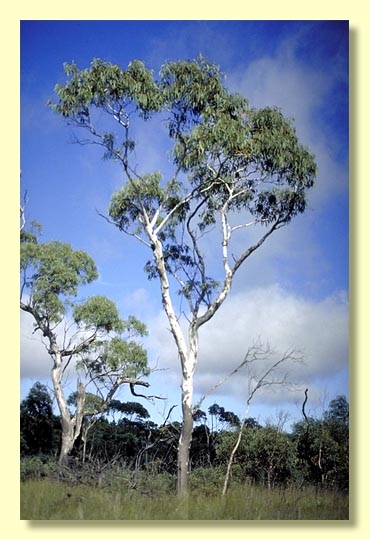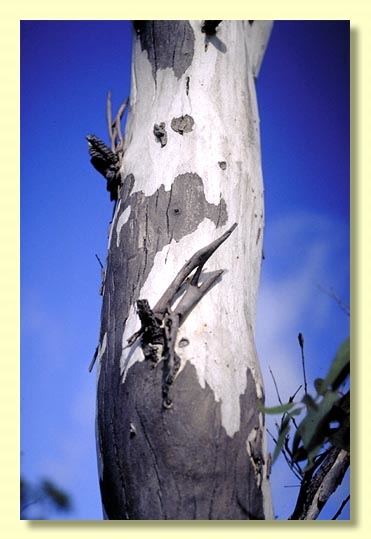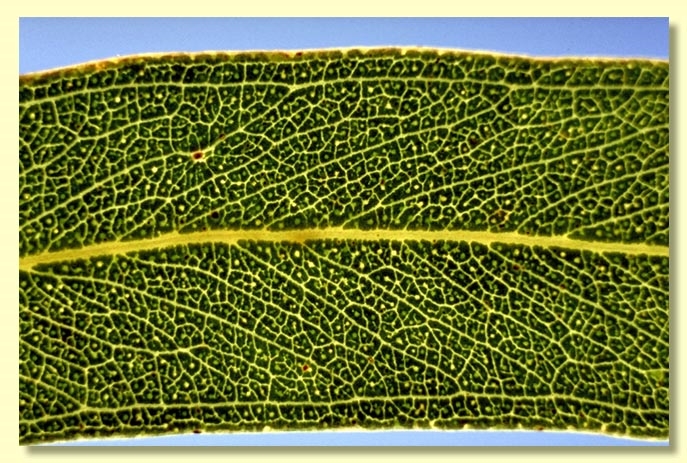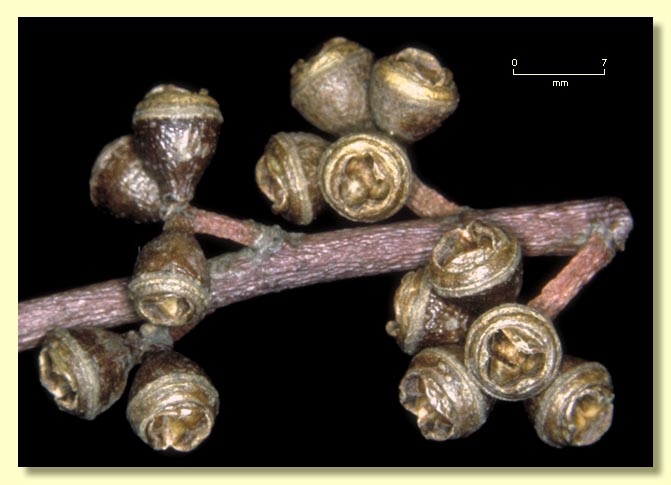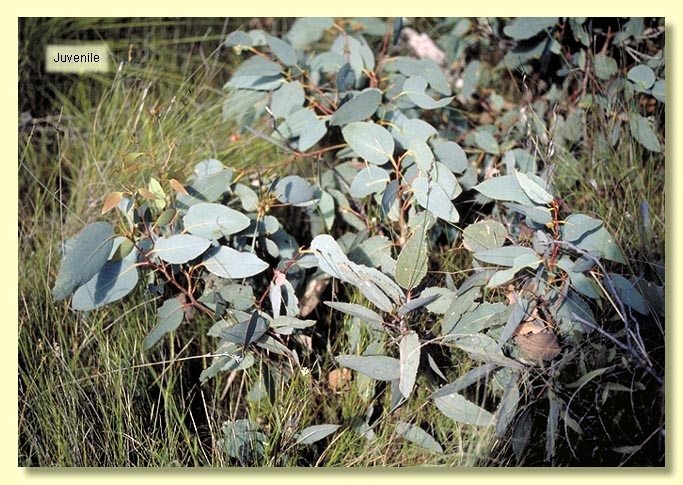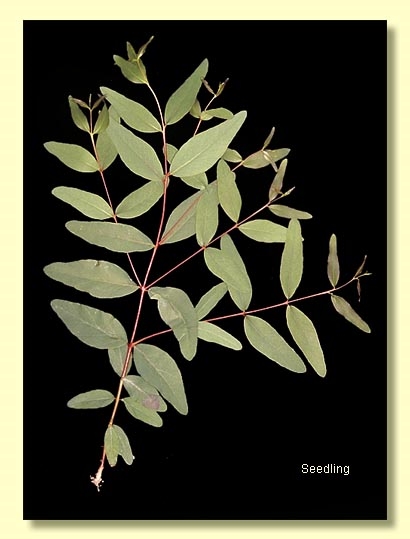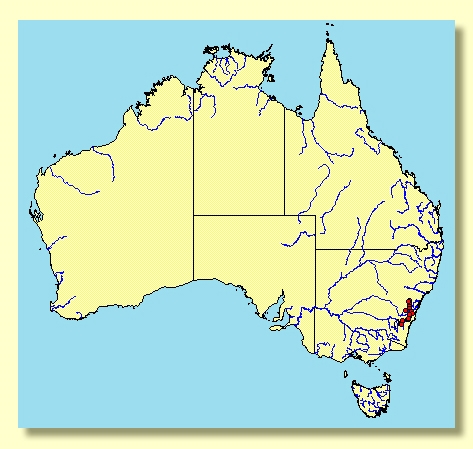Euclid - Online edition
Eucalyptus mannifera subsp. gullickii
Classification
Eucalyptus | Symphyomyrtus | Maidenaria | Triangulares | Microcarpae
Nomenclature
Eucalyptus mannifera subsp. gullickii (R.T.Baker & H.G.Sm.) L.A.S.Johnson, Contr. New South Wales Natl Herb. 3: 108 (1962).
Eucalyptus gullickii R.T.Baker & H.G.Sm., Res. Eucalypts 2nd edn, 128 (1920). T: Lawson, NSW, Aug. 1919, C.F.Laseron; holo: NSW.
Eucalyptus gullickii R.T.Baker & H.G.Sm., Res. Eucalypts 2nd edn, 128 (1920). T: Lawson, NSW, Aug. 1919, C.F.Laseron; holo: NSW.
Description
Tree to 20 m tall. Forming a lignotuber.
Bark smooth throughout, or with some persistent slabs of rough, grey bark at base of trunk; smooth bark powdery, white to cream or yellow but sometimes conspicuously dark grey on lower trunk.
Juvenile growth (coppice or field seedlings to 50 cm): stem rounded in cross-section; juvenile leaves opposite for a few pairs then alternate, petiolate or subsessile, elliptical to ovate or broadly lanceolate, 3–9.5 cm long, 1.4–3.2 cm wide, green to grey-green.
Adult leaves alternate, petiole 0.5–2.5 cm long; blade lanceolate to falcate, 5.5–17.5 cm long, 1–2.2 cm wide, base tapering to petiole, concolorous, glossy or dull, green to grey-green, side-veins at an acute or wider angle to midrib, densely reticulate, intramarginal vein parallel to and remote from margin, oil glands mostly island.
Inflorescence axillary unbranched, peduncles 0.4–1.2 cm long, buds 7 per umbel, pedicels 0.1–0.3 cm long. Mature buds obovoid to ovoid or diamond-shaped, 0.5–0.6 cm long, 0.3–0.4 cm wide, green to yellow, smooth, scar present, operculum conical to rounded, stamens inflexed or irregularly flexed, anthers cuboid or cuneate, versatile, dorsifixed, dehiscing by longitudinal slits (non-confluent), style long, stigma blunt, locules 3 or 4 each each with 4 vertical ovule rows on the placenta. Flowers white.
Fruit on pedicels 0.1–0.3 cm long, obconical, hemispherical or campanulate, 0.4–0.5 cm long, 0.5–0.7 cm wide, disc raised and oblique to convex, valves 3 or 4, exserted.
Seeds dark brown to grey, 1.3–2 mm long, ovoid or flattened-ovoid, often pointed at one end, often lacunose, dorsal surface shallowly pitted, hilum ventral.
Cultivated seedlings (measured at ca node 10): cotyledons more or less oblong; stems rounded in cross-section; leaves sessile or shortly petiolate, opposite for 5–17 nodes then becoming alternate, ovate-lanceolate to elliptic, 4.5–7 cm long, 1.5–3 cm wide, base tapering, margin entire, apex pointed, green.
Bark smooth throughout, or with some persistent slabs of rough, grey bark at base of trunk; smooth bark powdery, white to cream or yellow but sometimes conspicuously dark grey on lower trunk.
Juvenile growth (coppice or field seedlings to 50 cm): stem rounded in cross-section; juvenile leaves opposite for a few pairs then alternate, petiolate or subsessile, elliptical to ovate or broadly lanceolate, 3–9.5 cm long, 1.4–3.2 cm wide, green to grey-green.
Adult leaves alternate, petiole 0.5–2.5 cm long; blade lanceolate to falcate, 5.5–17.5 cm long, 1–2.2 cm wide, base tapering to petiole, concolorous, glossy or dull, green to grey-green, side-veins at an acute or wider angle to midrib, densely reticulate, intramarginal vein parallel to and remote from margin, oil glands mostly island.
Inflorescence axillary unbranched, peduncles 0.4–1.2 cm long, buds 7 per umbel, pedicels 0.1–0.3 cm long. Mature buds obovoid to ovoid or diamond-shaped, 0.5–0.6 cm long, 0.3–0.4 cm wide, green to yellow, smooth, scar present, operculum conical to rounded, stamens inflexed or irregularly flexed, anthers cuboid or cuneate, versatile, dorsifixed, dehiscing by longitudinal slits (non-confluent), style long, stigma blunt, locules 3 or 4 each each with 4 vertical ovule rows on the placenta. Flowers white.
Fruit on pedicels 0.1–0.3 cm long, obconical, hemispherical or campanulate, 0.4–0.5 cm long, 0.5–0.7 cm wide, disc raised and oblique to convex, valves 3 or 4, exserted.
Seeds dark brown to grey, 1.3–2 mm long, ovoid or flattened-ovoid, often pointed at one end, often lacunose, dorsal surface shallowly pitted, hilum ventral.
Cultivated seedlings (measured at ca node 10): cotyledons more or less oblong; stems rounded in cross-section; leaves sessile or shortly petiolate, opposite for 5–17 nodes then becoming alternate, ovate-lanceolate to elliptic, 4.5–7 cm long, 1.5–3 cm wide, base tapering, margin entire, apex pointed, green.
Flowering Time
Flowering has been recorded in February, March, April and May.
Notes
Eucalyptus mannifera is a widespread, small to medium-sized tree species of the Central and Southern Tablelands of New South Wales extending into the hills and slopes of eastern Victoria.
E. mannifera has predominantly or completely smooth, white bark that is powdery to touch and is easily recognised among gum-barked species by the form, bark, dull bluish green to green leaves and seven-budded inflorescences and small fruit. In places it co-occurs with another unrelated, smooth-barked white gum, E. racemosa subsp. rossii (a scribbly gum). On occasions E. racemosa subsp. rossii lacks insect scribbles on the bark and in these circumstances the two species can be superficially similar. E. mannifera has pale yellow newly exposed bark while E. rossii has brilliant yellow to orange new bark. E. mannifera has an operculum scar on the buds, lacking in E. racemosa subsp. rossii and the operculum is usually pointed in E. mannifera, rounded in E. racemosa subsp. rossii. Leaf reticulation in E. mannifera is moderate to dense whilst very sparse in E. racemosa subsp. rossii.
There are three subspecies:
E. mannifera subsp. mannifera
The most widespread and has linear to lanceolate juvenile leaves. Subsp. mannifera occurs from around Bathurst in mid-western New South Wales south into Victoria, east from the Snowy River to Mt Buffalo, Mt Baranduda and Paradise Falls, always on dryish, often stony sites.
E. mannifera subsp. praecox
Has rounded to ovate juvenile leaves and occurs north of Bathurst in the Liverpool Range Capertee area of New South Wales on dry sandy sites.
E. mannifera subsp. gullickii
Has elliptical to broadly lanceolate juvenile leaves and occurs usually adjacent to swampy sites in eastern New South Wales from the Blue Mountains and Megalong Valley, south to Pigeon House area.
Eucalyptus mannifera belongs in Eucalyptus subgenus Symphyomyrtus section Maidenaria, a large group of species more or less restricted to south-eastern Australia, characterised by bilobed cotyledons, simple axillary inflorescences, buds with two opercula, stamens with versatile anthers and flattened seeds with a ventral hilum. Within this section E. mannifera and three other species form series Microcarpae diagnosed by the smooth white bark, juvenile leaves that are shortly petiolate, non-swampy habitat, and small, rather flat-topped fruit. The other three species are E. scoparia (which differs in having glossy adult leaves), E. dorrigoensis (which has sessile stem-clasping ovate juvenile leaves) and E. elliptica (which has sessile large ovate-elliptic juvenile leaves).
E. mannifera has predominantly or completely smooth, white bark that is powdery to touch and is easily recognised among gum-barked species by the form, bark, dull bluish green to green leaves and seven-budded inflorescences and small fruit. In places it co-occurs with another unrelated, smooth-barked white gum, E. racemosa subsp. rossii (a scribbly gum). On occasions E. racemosa subsp. rossii lacks insect scribbles on the bark and in these circumstances the two species can be superficially similar. E. mannifera has pale yellow newly exposed bark while E. rossii has brilliant yellow to orange new bark. E. mannifera has an operculum scar on the buds, lacking in E. racemosa subsp. rossii and the operculum is usually pointed in E. mannifera, rounded in E. racemosa subsp. rossii. Leaf reticulation in E. mannifera is moderate to dense whilst very sparse in E. racemosa subsp. rossii.
There are three subspecies:
E. mannifera subsp. mannifera
The most widespread and has linear to lanceolate juvenile leaves. Subsp. mannifera occurs from around Bathurst in mid-western New South Wales south into Victoria, east from the Snowy River to Mt Buffalo, Mt Baranduda and Paradise Falls, always on dryish, often stony sites.
E. mannifera subsp. praecox
Has rounded to ovate juvenile leaves and occurs north of Bathurst in the Liverpool Range Capertee area of New South Wales on dry sandy sites.
E. mannifera subsp. gullickii
Has elliptical to broadly lanceolate juvenile leaves and occurs usually adjacent to swampy sites in eastern New South Wales from the Blue Mountains and Megalong Valley, south to Pigeon House area.
Eucalyptus mannifera belongs in Eucalyptus subgenus Symphyomyrtus section Maidenaria, a large group of species more or less restricted to south-eastern Australia, characterised by bilobed cotyledons, simple axillary inflorescences, buds with two opercula, stamens with versatile anthers and flattened seeds with a ventral hilum. Within this section E. mannifera and three other species form series Microcarpae diagnosed by the smooth white bark, juvenile leaves that are shortly petiolate, non-swampy habitat, and small, rather flat-topped fruit. The other three species are E. scoparia (which differs in having glossy adult leaves), E. dorrigoensis (which has sessile stem-clasping ovate juvenile leaves) and E. elliptica (which has sessile large ovate-elliptic juvenile leaves).
Origin of Name
Eucalyptus mannifera: Greek manna, gum and Latin -fera, bearing.
subsp. gullickii: after William Applegate Gullick (1859–1922). William Gullick became Government printer of New South Wales about 1898. Prior to that he worked for the well known firm of Messrs John Sands and Co. As Government printer he was responsible for major publications by R.T. Baker, H.G. Smith and J.H. Maiden. The high quality of these works owes much to the personal interest of Gullick.
subsp. gullickii: after William Applegate Gullick (1859–1922). William Gullick became Government printer of New South Wales about 1898. Prior to that he worked for the well known firm of Messrs John Sands and Co. As Government printer he was responsible for major publications by R.T. Baker, H.G. Smith and J.H. Maiden. The high quality of these works owes much to the personal interest of Gullick.
Copyright © CANBR 2020, all rights reserved.

Web edition hosted at https://apps.lucidcentral.org/euclid
